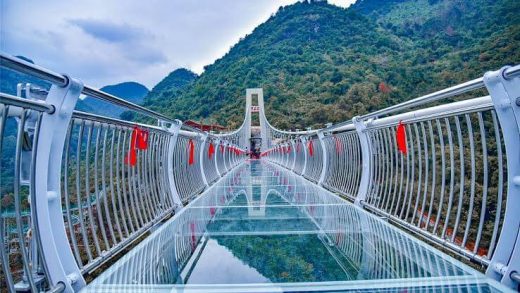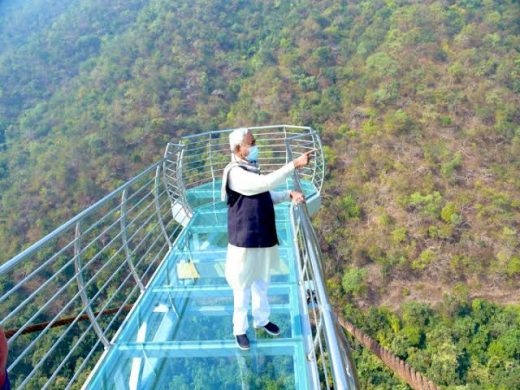Introduction:
In recent years, the construction of Glass Bridge has been developed. Glass bottomed and transparent architectures have attracted the attention of the public and it continuously brought benefits to tourist’s areas. It gives tourists beautiful visual experiences and great views of rivers and mountains in that area. The glass structured architecture deepened such perceptions of tourists and it became an adventure and expedition. Glass structured architecture uses their viewing platform or the function of the walking trails and the special performance of the glass integrates various design expressions.
Design principles for Glass Bridge:
- The measurements should suit local conditions.
- People oriented principles must be carried out.
- Safety and comfort must be ensured.
- Development must be sustainable.
- The aesthetic of patterns should be considered.

Fig 1: Glass Bridge in China’s Guangdong
Topography and terrain:
As it is a tourist-based architecture, it is generally built in areas with large height differences. The topography and the terrain would affect the feasibility of the construction structure. It will also affect the construction cost and safety of operation and maintenance during the construction of the project.
Environmental capacity:
As these architectures would bring large numbers of tourists, the surrounding environment plays a very crucial role in its construction. Mountain type tourist’s areas have limited space for exploration with fragile ecological environments.
Tourists flow:
In mountain and forest tourist areas, the available space for construction is limited. The development of Glass Bridge in such tourist areas should focus on the issue of tourists flow. Tourists flow is the number of tourists passing through per unit time. The tourists must be organized to visit the glass bridge in such areas. The flow affects the dispersion of the areas and the direction of tourist flow is an important reference for the determination of width and capacity of the bridge.
Streamline design and functional zoning:
It is very important to arrange road tours scientifically to prevent the tourists from repeatedly walking thereby causing congestion. Since the glass structured bridge is connected to the tourist’s areas, the site selection and road-stream is to be organized according to the flow of tourists. Special attention should be paid to the location of the sites which should be combined with other attractions in the tourist areas. This will avoid the isolation of certain attractions due to the unreasonable routes. The tourists flow could be divided and converged by guiding the behaviours of tourists through road flow lines and combining with construction of supporting facilities.
Safety issues:
During the construction process, safety issues are very important. It is important during the tour, the safe maintenance and reinforcement process. So, it should be considered during construction to build safer, more scientific and attractive glass bridges.
Material properties:
Glass is a fascinating material and it is an essential feature for modern architecture due to its property of transparency. Structural elements made using glass are capable of withstanding high pressure, wind and cold, rain, heat etc. the advantages of glass as a structural material includes durability, high light transmission, hardness and rigidity. The main disadvantage of glass is its vulnerability to breakage and shutters easily when stressed. Glass can be made more resistant to breakage by increasing the thickness. Initially glass behaves elastically until it has been stretched beyond its failure strength. At this point the glass breaks suddenly into fragmental pieces and produces dangerous shards of glass. It occurs without prior warning, so designers mostly avoid the risk of constructing load bearing elements made of glass. Study of glass became popular since 1980 after the discovery of laminated glass where its application can prevent sudden breakage of the material.
Properties of glass
| Properties | Values |
| Density Modulus of Elasticity Shear Modulus Poission’s ratio Yield strength Tensile strength Tensile ductility Compressive strength |
25000 kg/mm3 70-74 kN/mm2 30 kN/mm2 0.22 3600 N/mm2; fracture governed 5000 N/mm2; fracture governed 0 >1000 N/mm2 |
There are various types of glasses used in construction. For example, annealed float glass, toughened glass, laminated glass etc.
In a structure, loading can induce bending moments which are analyzed and assessed. After analyzing the values of bending moments, it is used to check the stress level developed in the members subjected to the load. For a structure made of glass, the undesirable characteristics of the material like brittleness can cause fracture especially where the flaws on the surface of the glass which normally leads to stress concentration. So the possibility of stress concentration cannot be overlooked and must be considered in the design procedure.
Due to the complexity of certain structures, these cannot be analyzed by conventional classical technique. Therefore these structural forms should be analyzed by using powerful tools like the Finite Element Method.
Glass bridges in use:
There are a number of incredible glass bridges and skywalks all across the world. Some of these are:
- Zhangjiajie Glass Bridge in Hunan, China.
- Tianmen Mountain in Hunan,China.
- Glacier Skywalk in Jasper National Park,Canada.
- Dachstein Skywalk in Salzburg, Austria.
Inspired by China’s Glass Bridge, a similar bridge is being constructed at Rajgir, Nalanda District in Bihar. It is constructed to boost adventure tourism. The project is expected to be completed by this year. The total length of the bride is 85 ft and 6 ft wide. It is situated at a height of 250 ft. It will be the first Glass Bridge in Bihar and second in the country.

Fig 2: Glass Bridge in Rajgir, Bihar
Conclusion:
The scientific layout of glass bridges in tourist areas should be considered at a very wide range from the perspective of sustainable development. The construction of glass bridges is increasing in these years. It increases tourism in that area. It is an effective way to enhance the attraction and competitiveness of the tourist areas. A scientific layout prior to construction and factors to be considered for sustainable construction of Glass Bridges are extremely important for durability of the structure.
If you have a query, you can ask a question here.



Is it possible to get details of who designed and built the rajgir glass bridge
Enquiry about constructing a glass bridge
Enquiry to find a construction team how have previous project records of glass bridge building
Is it possible to get details of who designed and built the rajgir glass bridge
Details of designer or consultant for Rajgir glass bridge required